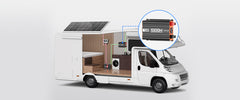
What Is an RV Battery Inverter? A Complete Guide for RV Owners
, 7 Tiempo mínimo de lectura


, 7 Tiempo mínimo de lectura
Ever wondered why your microwave won’t run directly off your RV battery? Your batteries store DC power, while most home appliances need AC power. The bridge between them is an RV battery inverter.
This guide explains what an inverter is, how it works, the types available, and how to size and maintain it for safe and comfortable off-grid living.
An RV battery inverter converts DC (from your battery bank) into AC (household electricity) so you can run appliances like:
☛ In short: An inverter converts your RV from a vehicle into a mobile home with usable AC power.
The process can be broken down into three steps:
a. Input – The inverter pulls DC power from your RV battery bank (commonly 12V or 24V).
b. Conversion – Electronic circuits transform the DC into AC power.
c. Output – The AC power is delivered through outlets, ready for your appliances.
* Think of an inverter as a power translator—it takes the language of your RV batteries and converts it into the universal language your appliances understand.
Not all inverters are created equal. Choosing the right type depends on the devices you plan to run.
|
Inverter Type |
Pros |
Cons |
Best For |
Cost Level |
|
Square Wave Inverter |
Lowest upfront cost |
Not compatible with most electronics; may damage sensitive devices |
Simple resistive loads (e.g., incandescent lights) |
$ |
|
Modified Sine Wave Inverter |
Affordable; works with many standard appliances |
May cause noise/heat/inefficiency in TVs, microwaves, or motors |
Budget builds with non-sensitive loads |
$$ |
|
Pure Sine Wave Inverter ✅ |
Clean, stable power; safe for sensitive devices |
Higher cost |
TVs, laptops, refrigerators, microwaves, and medical devices |
$$$ |
* Example: Rich Solar 2000W 12V Pure Sine Wave Inverter — 2000W continuous / 4000W surge, 12V DC in / 120V AC out. A reliable fit for small and medium RVs running refrigerators, TVs, and kitchen appliances.
Selecting the right inverter requires more than picking a wattage. Here are the steps:
Step 1: Calculate Your Power Needs
Formula: Inverter Size (W) ≥ Total Load (W) × 1.3
* Quick example: 700W microwave + 100W TV + 200W laptop = 1,000W
→ 1,000 × 1.3 = 1,300W → choose ≥1500W (or 2000W for headroom).
Step 2: Match Battery System Voltage
Step 3: Safety & Installation Features
Step 4: Plan for Growth
It’s easy to confuse these two devices, but they serve opposite functions:
|
Device |
Direction |
Purpose |
Typical Use Case |
|
Inverter |
DC → AC |
Runs AC appliances from batteries |
Off-grid powering of fridge, TV, laptop |
|
Converter |
AC → DC |
Charges batteries from shore/generator |
Battery charging at the campground or with a genset |
☞ Common mistake: Many RV beginners assume a converter can also run AC appliances—it cannot.
To get the most out of your inverter and protect your investment, follow these best practices:
Pro tips for longer battery life:
a. What size inverter do I need for my RV fridge?
Typical running: 150–300W; startup surge: 600–800W. A 1000W pure sine inverter usually suffices.
b. Can I run my RV air conditioner on an inverter?
Yes, but many AC units need 2000–4000W (or more). You’ll need a 3000W+ inverter and a robust battery bank—often paired with solar or a generator.
c. Can I use an inverter while driving?
Yes—if your alternator and batteries can support the load. Many RVers run fridges and chargers on the road.
d. How long will my battery run a given load?
Rough estimate: A 12V 200Ah battery ≈ 2400 Wh. A 600W appliance might run ≈ 4 hours before losses. Real-world time is lower due to inverter inefficiency and battery limits.
e. Do I really need a pure sine wave inverter?
For sensitive electronics (laptops, TVs, fridges, medical devices), yes—it’s the safest and most compatible choice.
f. Can I connect solar panels directly to an inverter?
No. Solar panels must first go through a solar charge controller to safely charge your batteries. The inverter then draws from the batteries.
g. What size inverter for a 30-amp RV?
A 30A RV service is 120V × 30A = 3600W max. Many users pick 2000–3000W pure sine inverters and manage loads, or go larger if they expect heavy use.
An RV battery inverter is the heart of your off-grid power system—it turns battery DC into clean AC so you can live comfortably anywhere. To choose wisely:
✨ Ready to upgrade? The Rich Solar Pure Sine Wave Inverters stand out as proven solutions. With the right setup, you’ll enjoy true energy independence and the freedom to travel without limits.